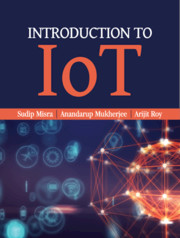17 - IoT Analytics
Published online by Cambridge University Press: 09 January 2021
Summary
Learning Outcomes
After reading this chapter, the reader will be able to:
Describe the common analytical tools and machine learning algorithms used with IoT data
Assess the importance and applicability of each algorithm
Understand the operating principle of each of these analytical methods
Assess the performance of various analytical and learning algorithms and methods through the use of various performance metrics
Relate to the uses of various learning algorithms through examples
Introduction
In previous chapters, we learned that sensors are an intrinsic part of IoT. These sensors collect data from the environment and serve different IoT-based applications. The raw data from a sensor require processing to draw inferences. However, an IoTbased system generates data with complex structures; therefore, conventional data processing on these data is not sufficient. Sophisticated data analytics are necessary to identify hidden patterns. In this chapter, we discuss a few traditional data analytics tools that are popular in the context of IoT applications. These tools include k-means, decision tree (DT), random forest (RF), k-nearest neighbor (KNN), and density-based spatial clustering of applications with noise (DBSCAN) algorithms. Before discussing these algorithms, let us understand some of the basics related to machine learning (ML).
Machine learning
The term “machine learning” was coined by Arthur Lee Samuel, in 1959. He defined machine learning as a “field of study that gives computers the ability to learn without being explicitly programmed”.
ML is a powerful tool that allows a computer to learn from past experiences and its mistakes and improve itself without user intervention. Typically, researchers envision IoT-based systems to be autonomous and self-adaptive, which enhances services and user experience. To this end, different ML models play a crucial role in designing intelligent systems in IoT by leveraging the massive amount of generated data and increasing the accuracy in their operations. The main components of ML are statistics, mathematics, and computer science for drawing inferences, constructing ML models, and implementation, respectively.
Points to ponder
ML is an important tool, which is used by different social networking websites such as facebook and twitter.
Autonomous vehicles use ML to determine their paths and speeds.
- Type
- Chapter
- Information
- Introduction to IoT , pp. 355 - 374Publisher: Cambridge University PressPrint publication year: 2021

